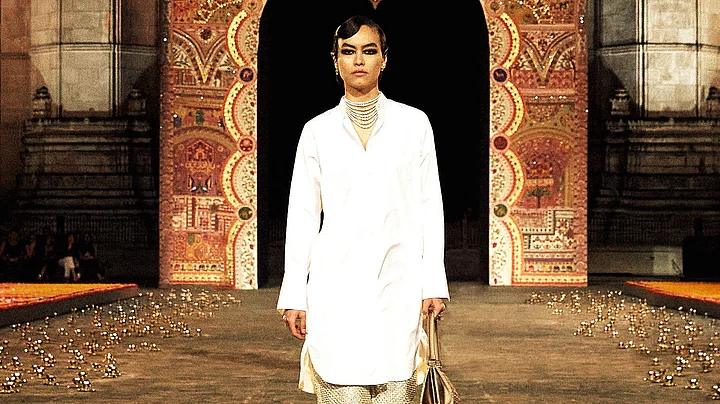In 1947, six months before India got independence from British colonial rule, Christian Dior unleashed another kind of revolution with his first collection later christened the 'New Look'. A long and full skirt, rounded shoulders, and a cinched waist. The newness of this look was an act of rebellion against the war-time necessities—economic and ergonomic—namely straight skirts with knee-length hems, night robes et al. For the next seven years, Christian decided to define and redefine this primary idea of his sartorial vision.
Now, vision is something that was conspicuous by absence in Dior's latest show in Mumbai. This essay is not a critique of the spectacle that Dior conjured at the iconic Gateway of India but a lament for fashion and design. When a hyped moment fails to deliver, when it comes from a style revolutionary that brought us characteristic draped necklines and fitted waistlines, or the “Zig Zag”, or even the self-fabric-covered buttons, it hurts particularly bad.
Did Dior Do Enough?
Yes, it was thrilling to see a world heritage site being transformed into a fashion ramp. But that's what Maria Grazia Chiuri has been doing lately. Remember the Athens show?
Yes, it was heartwarming to have the artisans from a Mumbai-based craft school being acknowledged as partners in Dior's fashion journey. So what? Is this not the right thing to do in terms of fair trade practices?
Yes, there was a nod to 'Indian-ness' through the ramp design complete with a rangoli and folk tunes like "ghoomar". Isn't it, however, a case of blatant essentialising of a culture? Bordering pastiche?
But, what about clothes? The dress. The characteristic Dior philosophy of continuity coupled with evolution?
Fashion Is Now, Decidedly, Art
Since 2016, Dior has been partnering with Karishma Swali, the director of the Chanakya School of Craft, and incorporating the creative output from the Mumbai-based institution into set designs, bags, and statement couture pieces. The pre-fall 2023 show was, thus, an on-site salute to Indian embroidery, a living and breathing heritage.
But can or should fashion be only seen through the lens of correctness? Anne Hollander says that dress is “a form of visual art, a creation of images with the visible self as its medium". Therefore, fashion should be accorded the same rigour by “studying their formal, strictly visual properties in the light of previous and concurrent ones, as is usually done in studying changes in styles of art.”
Dior's India-inspired collection—with its almost 200 looks—does not wow when the art paradigm is used. The clothes have all been seen before, with utterly familiar drapes and silhouettes. This pre-fall collection was showcased in Dec 2022 and a lot has been written about the India inspiration: the Jardin Indien toile de jouy pants, the Nehru collar, the Madras checks, and other such trans-continental elements.
During the showcase, Chiuri told a leading fashion magazine, "Fashion is not only about clothes. It’s a way of knowing each other.” Yes, it is. But by now, we ought to know each other a lot better than merely incorporating the most identifiable motifs and styles.
The Attack of the Unsexy
There's also a minor point about sexiness—or, its absence. Fashion has long withstood the charge of being anti woman. And in many ways, it indeed is. French haute couture, in particular, has been a favourite punching bag. A reporter in L'Express wrote in as early as the 1960s, "In the domain of spectacle, French haute couture has attained a sort of perfection. In the art of dehumanising women it has almost succeeded". The problem of the male gaze is still going strong.
Chiuri is a champion of easy and comfortable luxury—somewhat of an anti-corset crusader. She has been professing the need for clothes that feel good on the skin of the wearer. However, being comfortable does not necessarily have to mean uninspired. It doesn't mean un-sexy.
Even one of the staunchest critics of 'fashion', noted feminist Simone De Beauvoir wrote in The Second Sex, "woman allies herself to nature while bringing to nature the need of artifice; for man she becomes flower and gem—and for herself also".
Dior Had the Dali Dress, Where Is Chiuri's Response?
Mix and match, layered outfits, day-to-evening ensembles have been around for a while. What exactly has been the Dior contribution to the utility fashion? Even the play around drapes of saree does not make one sit up and take notice of the legendary fashion house's innovation. Compare this collection to the drapes of Roksanda Ilincic or our own Nikhil and Shantanu to realise that Chiuri's effort was not enough. Even a new kind on the block, Miss Sohee, has been hitting it out of the park while incorporating indigenous motifs in revolutionary and sexy ways.
Christian drew inspiration from high-brow artists like Salvador Dali and collaborated with them. Chiuri is big on collaborations, so where is her response to the 'Dali Dress' that Christian had created? Indian art, in different mediums, and artists have been inspiring trends across the world for centuries. Why did Chiuri miss this bus?
This India inspired collection could have opened floodgates for a genuinely high moment in fashion history had Chiuri managed to scratch beneath the surface of tigers, peacocks and the like.
(At The Quint, we question everything. Play an active role in shaping our journalism by becoming a member today.)
